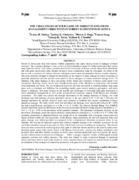| dc.description.abstract | Forests in Africa and Asia host various wildlife populations that cause varying levels of damages to forest resources. The economic damage is more severe in forest plantations meant for timber production that require huge financial outlays. Like many countries most forest ecosystems in Kenya contain many forest plantations and wild game conservation units. Despite the heavy losses to plantation crops by wild game, the extent of the loss as well as existence of a balance between wild game conservation and plantation forestry remains unknown. The study therefore attempts to deepen the knowledge on the impacts of game damage on forest ecosystems in particular plantations and also provide some option to forest managers to counter minimize damage levels. To minimize wild game damages in Key ecosystems of Mt. Kenya and Aberdares in Kenya game moats were constructed. Recently, electric fences were introduced into parts of the Aberdares to keep away wild animals from plantations and farms. The use of physical structures has been successful in reducing damage from large game such as elephants and buffaloes but controlling smaller game mostly monkeys, porcupines, and moles remain a challenge. This paper focuses on the benefits and challenges of restricting wild game movement in forest plantations management as well as the ecological and economic impacts in Mt Kenya and Aberdare ecosystems. The study was carried out through assessments of the damage intensity of foliage, tree limb breakages and bark damages of major plantation species in the age cohorts 5-10, 11-20 and > 20 years old. Damage attribution by specific group of game was evaluated to establish their overall contribution to forest plantation damages. The study results show that individual site damages were statistically different (P < 0.05) but had a weak Pearson correlation (rs = 0.46, n = 8, P = 0.05). The Duncan Multiple Range Test (DMRT) showed significant statistical differences in the two ecosystems but exhibited a strong negative correlation (rs = 0.97, n = 8, p < 0.05) in the prevalence of the causative animals . The Spearman Correlation Analysis on the prevalence of damages across the species showed a strong positive correlation (rs = +0.88, n = 8, P < 0.05). The economic production of plantation forests was found not to be compatible with wild game conservation but degree differed within the two ecosystems. In Mt Kenya, where plantations are not well protected from wild game, damage was widely prevalent as compared to the well-protected Aberdares ecosystem where it was minimal. The fencing off approach significantly reduced elephant damage in the Aberdare ecosystem but the restriction caused an increase in pressure on other critical forest resources resulting in overgrazing. The electric fence has been successful in restricting large wild game in Aberdare forests and hence the need to replace nonfunctional game moats with electric fences in Mt Kenya. Concurrently, carrying out habitat enrichment with preferred diets and other fallback resources in buffer zones between production units will provide the muchneeded critical resource to destructive wild game. Other strategies explored include well-designed animals migration corridors and culling measures. The study was limited in scope to physical damage to plantation forests and hence there is need widen studies to cover economic losses and impacts on natural forests to enable development of best strategies of controlling destructive wild game in forest ecosystems. | en_US |
